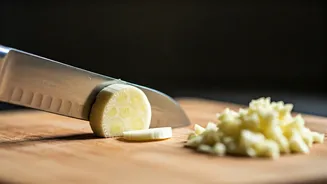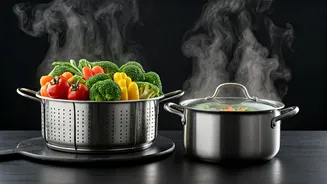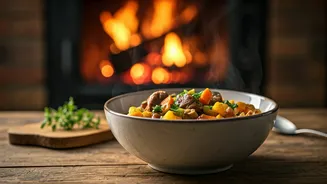Mincing for Boldness
Mincing garlic is the go-to method for releasing its most potent flavors. The finely chopped pieces expose maximum surface area, allowing the allicin compounds
to fully develop. This is ideal when you want an intense garlic presence in your dish, such as in garlic bread or a robust marinara sauce. The process involves peeling the cloves, removing the root end, and finely chopping with a chef's knife. To make the task simpler, you can use a garlic press, which also minces garlic quickly. Remember that minced garlic is also the best option when you desire an all-around garlic flavour.
Dicing for Uniformity
Dicing garlic yields small, uniformly sized pieces, providing a balance of garlic flavor and texture. This method is perfect for dishes where you want to evenly distribute the garlic throughout. Begin by mincing the garlic, then chop it into small, equal-sized cubes. Dicing ensures that garlic cooks uniformly, preventing some pieces from burning while others remain undercooked. This technique is appropriate for stir-fries, stews, or any recipe requiring consistent flavor distribution. Proper dicing can also improve the appearance of the dish.
Slicing for Elegance
Slicing garlic creates thin, delicate pieces that offer a subtle garlic flavor and a pleasant texture. This method is useful when you want to infuse a dish with garlic without overpowering it. Slicing garlic works particularly well in oil-based dishes, where the thin slices gently sizzle and release their aroma. Start by carefully peeling the cloves and slicing them into thin, even pieces using a sharp knife. This technique is ideal for adding flavor to pasta, sautéed vegetables, or topping for pizzas. The thin slices bring a touch of elegance to any dish.
Chop for Versatility
Chopping garlic offers a middle ground between mincing and dicing, resulting in a slightly coarser texture. The chopping method involves breaking the cloves into irregular pieces, which lends a varied flavour and texture to dishes. This technique is ideal for dishes where you want a hint of garlic without making it overly strong. Chop garlic using a chef's knife to roughly break down the cloves, allowing for some larger and smaller pieces. This method is versatile, working well in omelets, salads, or various sauces. It's also great for quick cooking.
Smashing for Aroma
Smashing garlic is a quick and effective method to infuse oils or sauces with a gentle garlic aroma. Unlike mincing or chopping, the garlic remains in larger pieces after smashing, releasing the aromatic compounds without making the flavour overpowering. To smash garlic, place a clove on a flat surface and press down firmly with the flat side of a chef's knife, or use a pan. This method is beneficial for infusing oils, making it easy to remove the garlic pieces later. Smashing is very good when you need a gentle flavour in dishes such as soups or stews.
Roasting for Sweetness
Roasting garlic transforms its sharp bite into a mellow sweetness, adding depth to many dishes. Roasting mellows the pungency by slowly caramelizing the natural sugars in the garlic. To roast garlic, wrap whole, unpeeled bulbs or individual cloves in foil and bake until soft and golden brown. This technique is ideal for creating a spread or dipping sauce. The result is a smooth, caramelized garlic that is a delightful addition to roasted vegetables, pasta sauces, or spread on bread. Roasted garlic adds a luxurious, sweet flavour.
Grating for Finesse
Grated garlic is the finest cut, perfect for incorporating into sauces or dressings without imparting large pieces of garlic. The technique involves grating fresh garlic cloves on a microplane or fine grater, creating a smooth paste. This method releases a potent flavor without the chunks. Grated garlic blends easily into dressings or sauces, providing a smooth texture and even distribution of flavour. This is perfect for vinaigrettes, marinades, or any recipe where you want the garlic to be undetectable. The fine texture ensures even flavour.










